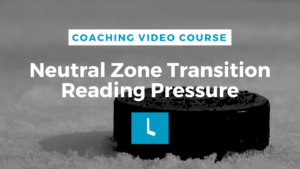(Transcribed from How to Play Hockey: Our Minor Hockey Coaching Course.)
In this video we’re going to combine a few terms that are relevant all over the ice. We’re going to talk about…
- Gap Control (Again)
- Close Coverage
- Sagging..…and how they play out in different zones.
[maxbutton id=”2″ ]
Gap Control:
Gap Control is the one that’s most common that we have talked about in the previous video. The gap is the distance between a retreating D and the attacking FWD. In general, we want that to be within about stick length and you can think about that because you’re in distance to be able to poke check that offensive player. Also it allows you to match the speed of the attacking forward. If you back in too far then you’ll end up slowing down as you come into the zone and this attacking forward hits you with too much speed.
So the goal is to match the speed and be just about a stick length away in poke-checking range.
You can learn more about how to poke-check properly in the “How to” video on the Poke Check.
Close Coverage:
Now depending on how close the puck is to your man that may often dictate how close you are to covering that player.
Example:
There is an attacking FWD is in the corner possessing the puck looking for play options.
- Naturally our D1 needs to be in very close coverage here.
- Our D2 is net front and may have a bit more of a gap from their high forward in the zone and there stick in the passing lane which we’ve talked about.
- Our strong side W isnt stuck to his opposing D that he is covering as that can lead to having the D jumping in behind to the slot and being open. An easy reference point to think of is in line with the dots. This way we see the play in the corner develop and we can keep an eye on our opposing D for good coverage.
- Quite common for the weak side W is the sag in the middle of the ice just above the hash marks, helping support the middle of the ice or the “fort”. That way if the puck ever moves up the wall and then over the the opposing teams weak side D, he/she is able to get up and into the shooting lane.
- With the weakside W in this position we have to also be sure as the strong side W to have our stick in the passing lane and our body ready to be in the shooting lane.
In general if you’re on the strong side you’re going to be checking a little tighter. Checking looser or sagged on the weak side just gives you a little bit more time and space to react to a change in situation. And if the puck were to come out of your end into the slot you’re able to just jump down and help out a little bit.
Some coaches want to have the W’s play man-on-man coverage very tight to the opposing D to completely neutralize them from the play. But the argument against that is it creates too much open space in the prime scoring area of the ice and the W’s aren’t able to help out as well.
So it is a philosophical decision. But in general we believe that strong side coverage needs to be a little bit closer or a little bit tighter.
Another term that we talked about…Committing On Defense For Stalling
This is in regards to how much control the offensive of player has. So if the offensive force from the other team has full control of the puck and is facing the middle of the ice our defender may have to Stall or Contain this attacking forward for fear of committing. Especially if they’re very skilled and can slide the puck through and go around and walk out.
Having said that, the opposite of that is if the attacking FWD is fighting to get control of the puck or maybe even has his/her back to the play then this defender can commit a little bit more and play a much tighter defense rather than containing.
You see a lot in soccer where the ball carrier has full control, then that attacker may just contain and stall a little bit more. Trying to shout over, shield or angle or steer…all these words we’ve talked about in previous videos keeping that player to the outside. So it’s a decision in a matter of how much puck control does that offensive player have them covering and how skilled they are. The more skilled they are the more control they have. The less you’re going to be able to commit and go right after them. You’ll see this often on the penalty kill. Check out the video to get a detailed description!
Looking to download half ice hockey practice plans, goalie drills for teams (not a goalie coach?!) or small area games drills? We’ve got you covered too. Click here. Perfect for recreational level coaches.





